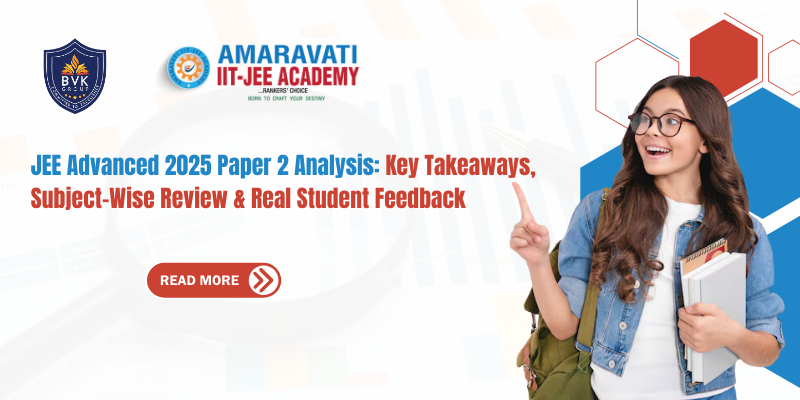
JEE Advanced 2025 Paper 2 Analysis: Key Takeaways, Subject-Wise Review & Real Student Feedback
JEE Advanced 2025 wasn’t just another exam—it was a mind game. And Paper 2 took that game to the next level. After the moderate surprise of Paper 1, aspirants expected Paper 2 to be either easier or similar in difficulty. But instead, it brought in a clever mix of multi-concept problems, mental fatigue, and time traps.
For many students, the second paper felt like a battle of strategy more than just knowledge. Some walked out feeling confident, while others admitted they struggled to keep pace despite knowing the concepts. But what separated the high performers from the rest wasn’t just how many questions they attempted—it was how smartly they navigated the paper.
In this article, we’ll unpack everything from subject-wise trends to the difficulty level, types of questions asked, and even strategies used by toppers and BVK Group students. If you’re preparing for 2026 or mentoring someone who is, these insights are more than useful—they’re essential.
Why Reviewing the Exam Matters More Than Just Attempting It
Attempting the paper tests your knowledge. But reviewing the paper? That’s where the learning multiplies.
When students revisit Paper 2, they discover:
- How they lost marks on silly errors
- What kind of questions tricked them
- How their time allocation broke down
- And what high-frequency chapters mattered
Subject-Wise Breakdown of Paper 2: What Made It Tick?
Physics: Application Over Memorization
This section leaned heavily on real-world application and conceptual visualization. Students who just memorized formulas felt stuck.
High-weight chapters included:
- Capacitors & Electrostatics
- Surface Tension & Fluid Mechanics
- Advanced Mechanics (Rotational + SHM combo)
Notable types of questions:
- A question involving a spinning disc on a sloped surface tested torque and friction concepts simultaneously.
- Capacitance problems blended with geometry to confuse students.
Difficulty Level: Moderate to High
Student Tip: “Drawing diagrams saved me 5–6 marks easily.
Chemistry: Blended Balance Between Recall & Logic
Chemistry, though initially considered easier, surprised students with concept traps in Physical and Organic Chemistry.
Key chapters:
- Coordination Compounds (tricky isomerism)
- Thermodynamics (non-standard questions)
- Organic Mechanisms (multi-step, unstable intermediates)
What caught students off guard:
- IUPAC naming + reaction mechanism combined in match-the-column
- Surface-level NCERT readers missed conceptual nuances
Mathematics: The Ultimate Mind Game
Math Paper 2 was arguably the most challenging section of the day. Logic-heavy, layered problems made it a mental marathon.
Focus areas:
- Probability & Statistics
- Application of Derivatives
- 3D Geometry & Vectors
- Complex Numbers
Types of traps:
- Integer-type questions with no obvious method
- Multi-concept Matrix Match questions (e.g., integration + inequality + trigonometry)
Topper Insight: “I used the ‘1st pass rule’ — attempted all MCQs first, marked doubts, then tackled integers. It helped me survive.”
What Kinds of Questions Appeared?
The structure and variety of the paper also influenced student performance.
- Multiple Correct Type – Forced deep thinking
- Integer Type – Tested precise logic; no room for guesswork
- Match the Column – Cross-topic questions that caught even advanced students off guard
Overall Difficulty: Was Paper 2 Tough?
Yes, most students agreed that Paper 2 was more mentally taxing than Paper 1.
- Physics required visualization
- Chemistry needed calm application
- Math tested patience under pressure
High-Yield Chapters That Dominated
Here’s what stood out in Paper 2 based on topic frequency and weight:
| Subject | Dominant Chapters |
| Physics | Rotation, Fluids, Electrostatics |
| Chemistry | thermodynamics, Coordination Compounds, Mechanisms |
| Math | Probability, 3D Geometry, Matrices |
BVK’s Targeted Revision Program focused extensively on these chapters in the last 30 days, giving students a strategic edge.
What Toppers Did Differently in Paper 2
- Mock Strategy Simulation
They treated every BVK mock like the real exam—no breaks, no distractions, post-analysis compulsory. - Error Tracking
They had a “Mistake Diary” to analyze each error: Was it a silly mistake, misreading, or weak concept? - Selective Solving
Instead of trying to solve everything, they selected 60–70% of questions and ensured 90% accuracy. - Last 60-Day Planning
Top scorers followed the 3:2:1 Rule:
- 3 full mocks/week
- 2 revision sessions/day
- 1 mentor meeting/week
What BVK Group Students Said About Paper 2
- BVK’s Paper 2 simulation was 90% identical — especially those weird integer-type maths questions.”
- Thanks to the Mistake Tracker, I knew exactly what kind of errors to avoid.”
- The Top 100 BVK Revision Booklet covered 6 direct concepts that came in Paper 2!”
Conclusion: The Real Lessons from Paper 2
JEE Advanced 2025 Paper 2 analysis wasn’t just about subject strength. It was about:
- Emotional control
- Efficient strategy
- Smart question selection
- Staying calm during unexpected challenges
For those preparing for 2026, this isn’t just an analysis—it’s a roadmap. Follow the pattern, not the panic.
Frequently Asked Questions (FAQs)
1. Was Paper 2 tougher than Paper 1 this year?
Yes, Paper 2 felt more logic-based and mentally exhausting, especially in Math and Physics.
2. Is the NCERT alone enough for Chemistry in Paper 2?
No. It’s essential for Inorganic, but Physical and Organic demand coaching-level practice.
3. Which subject took the most time in Paper 2?
Math. Most students found its questions long and tricky.
4. What were the dominant chapters in Paper 2?
Rotation, Fluids, Thermodynamics, Matrices, and Probability led the paper.
5. How close were BVK’s mock tests to Paper 2?
Very close — question types and difficulty closely matched the actual exam.
6. What helped most from BVK’s preparation tools?
Mistake Tracker, Top 100 Booklet, and expert mentor feedback stood out.
7. Did BVK mocks have similar questions to the real paper?
Yes, especially in topics like Matrices, Rotation, and Coordination Compounds.
8. How did BVK train students for exam pressure?
Through regular, timed mocks, stress drills, and focused last-mile mentoring.